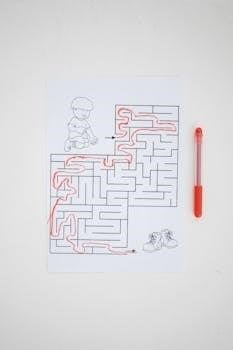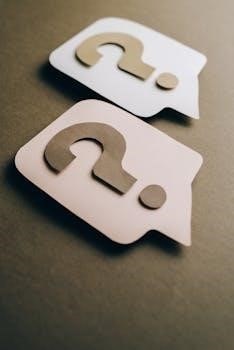This section introduces fundamental concepts‚ distinguishing between pure substances like elements and compounds‚ and mixtures. It emphasizes understanding their composition and properties. This understanding is crucial for further study in chemistry. We will explore these concepts in the following sections.
Defining Elements⁚ The Basics
Elements are the most fundamental substances in chemistry‚ defined as pure substances containing only one type of atom. These atoms are the basic building blocks of all matter and cannot be broken down into simpler substances by ordinary chemical means. An element is always uniform‚ or homogenous‚ throughout. Each element is represented by a unique symbol‚ as found on the periodic table. Examples of elements include iron (Fe)‚ oxygen (O)‚ and gold (Au). Elements are the purest form of matter and serve as the foundation for all other chemical substances. They are characterized by their unique properties‚ which are determined by the number of protons in their atoms. Understanding elements is crucial for grasping the concepts of compounds and mixtures. They are the individual components that‚ when combined‚ form the complex world of chemistry. The study of elements is the starting point for understanding all matter.
Understanding Compounds⁚ Formation and Properties
Compounds are pure substances formed when atoms of two or more different elements chemically combine. This combination occurs through chemical reactions‚ resulting in the formation of chemical bonds that hold the atoms together. Compounds have properties that are distinct from those of the elements that compose them. A compound has a fixed composition‚ meaning the elements are always present in a specific ratio. For example‚ water (H2O) always consists of two hydrogen atoms and one oxygen atom. Compounds can be broken down into their constituent elements through chemical means‚ but this usually requires a significant amount of energy. The formation or decomposition of compounds often involves the release or absorption of heat‚ further showcasing the strong chemical bonds within them. Most pure substances found in nature are compounds‚ highlighting their abundance and importance in the chemical world. Examples include sugar (C6H12O6) and salt (NaCl). Understanding compounds is vital for comprehending how different substances interact and react.

Key Differences Between Elements and Compounds
Elements are pure substances made of only one type of atom‚ while compounds are formed from two or more different elements chemically combined. This chemical bonding gives compounds unique properties unlike their constituent elements.
Fixed Composition of Compounds vs. Variable Composition of Mixtures
A key distinction lies in the composition⁚ compounds have a fixed‚ definite composition. This means that the elements within a compound are always combined in the same specific ratio by mass. For example‚ water (H₂O) always has two hydrogen atoms for every one oxygen atom. This fixed ratio is a fundamental characteristic of compounds‚ resulting from chemical bonds. On the other hand‚ mixtures exhibit a variable composition; their components can be mixed in different proportions. This means that the ratio of elements or compounds in a mixture can vary. For instance‚ a salt and water mixture can contain different amounts of salt. This variability stems from the components not being chemically bonded‚ but rather physically combined. This difference in composition is a major factor in distinguishing between compounds and mixtures and how they behave.

Mixtures⁚ Homogeneous and Heterogeneous
Mixtures are classified based on their uniformity. Homogeneous mixtures have a uniform composition throughout‚ like saltwater. Heterogeneous mixtures‚ such as sand and water‚ have visible‚ distinct components. Understanding this difference is essential.
Separating Mixtures⁚ Physical Methods
Mixtures‚ unlike compounds‚ can be separated using physical methods because their components are not chemically bonded. These methods exploit differences in physical properties such as boiling points‚ particle size‚ or magnetic properties. Common techniques include filtration‚ which separates solids from liquids using a porous barrier. Another method is evaporation‚ used to separate a soluble solid from a liquid by heating the mixture until the liquid vaporizes. Distillation is employed to separate liquids with different boiling points by heating the mixture and collecting the condensed vapors. Magnetic separation uses a magnet to remove magnetic substances from non-magnetic ones. Decantation involves carefully pouring off a liquid from a solid that has settled. These methods are crucial in various applications‚ from laboratory analysis to industrial processes‚ highlighting the versatile nature of physical separation techniques in dealing with mixtures.

Worksheet Exercises⁚ Classification and Identification
This section provides exercises to classify substances as elements‚ compounds‚ or mixtures. It includes activities to identify these categories using descriptions and diagrams‚ enhancing understanding of their fundamental differences. These exercises help solidify learning.
Matching Diagrams to Elements‚ Compounds‚ and Mixtures
This exercise focuses on visually distinguishing between elements‚ compounds‚ and mixtures using diagrams. Students will be presented with various representations of substances at the atomic or molecular level. The task involves matching these visual depictions to their correct classification. For instance‚ a diagram showing only one type of atom would be matched to the “element” category. Diagrams showing two or more different types of atoms chemically bonded together would correspond to compounds. Conversely‚ diagrams showing different substances not chemically bonded would represent mixtures. This activity strengthens students’ understanding of how composition at the microscopic level dictates the classification of matter. By analyzing these diagrams‚ learners will develop a deeper understanding of the differences between pure substances and mixtures. This section will also help to reinforce the concept of homogenous and heterogeneous mixtures. The aim is to consolidate their ability to differentiate between elements‚ compounds‚ and mixtures.

Worksheet Exercises⁚ Identifying Elements‚ Compounds and Mixtures
This section provides practice in classifying substances. Students will identify given materials as either elements‚ compounds‚ or mixtures. Exercises aim to reinforce knowledge of their defining characteristics. This will solidify understanding of chemical composition.
Multiple Choice Questions on Elements‚ Compounds and Mixtures
This section presents multiple-choice questions designed to test your understanding of elements‚ compounds‚ and mixtures. These questions will cover topics such as identifying substances based on their composition and properties. They will also assess your knowledge of the differences between pure substances and mixtures. Some questions may involve interpreting chemical formulas and diagrams to correctly classify materials. Expect questions that require distinguishing between homogeneous and heterogeneous mixtures. Furthermore‚ you might encounter questions that focus on the chemical or physical nature of substance formation. You will also be asked to identify examples of elements‚ compounds‚ and mixtures in everyday contexts. Pay attention to the details in each question and use your knowledge to select the most accurate answer from the options provided. This exercise will solidify your understanding of the concepts and enhance your ability to apply them in different scenarios. The answers to these questions will help you evaluate your comprehension of the core ideas of this topic.
Worksheet Answers⁚ Key to Exercises
This section provides the solutions to the exercises presented in the worksheet. It will allow you to check your answers and understand any mistakes. Detailed explanations might also be included to clarify any confusion.
Free Printable Worksheets and Resources
This section offers access to free‚ downloadable worksheets focused on elements‚ compounds‚ and mixtures. These resources are designed to support learning and practice. These worksheets often include varied exercises‚ from classification tasks to multiple-choice questions‚ facilitating a comprehensive understanding of the topic. They are available in PDF format for easy printing and use. You can find a variety of worksheets tailored for different grade levels and learning styles. These resources aim to make the learning process engaging and effective‚ ensuring students grasp the core concepts. Such materials are ideal for classroom instruction‚ home study‚ or review sessions. The worksheets come with answer keys to enable self-assessment and immediate feedback. These printable resources are designed to be convenient and accessible‚ assisting both educators and learners in their study of chemistry. Furthermore‚ they cover a range of topics related to the classification and identification of elements‚ compounds‚ and mixtures. These free worksheets are an excellent tool for strengthening understanding and retention of fundamental chemical concepts.



